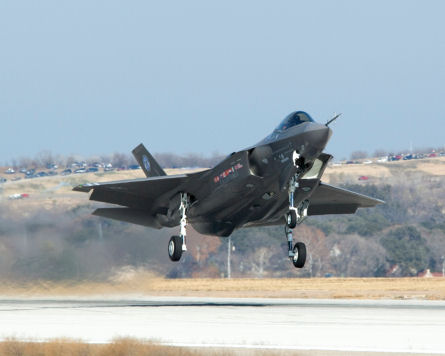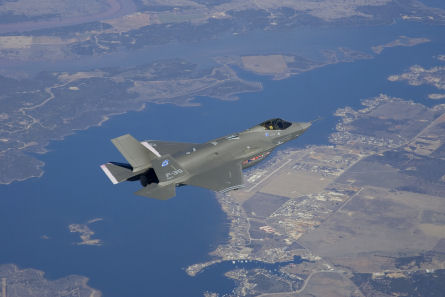With test flights of the first Lockheed Martin F-35 Joint Strike Fighter now into double digits, Pratt & Whitney's F135 engine is delivering impressive operability and reliability - and plenty of power.
| |
|---|
|
|---|
The same F135 has powered the F-35 since its maiden flight in December |
The 40,000lb (300kN) thrust-class F135 is the most powerful fighter engine ever developed, and a key part of the most complex combat-aircraft programme ever attempted. The engine will power three variants of the F-35 that are under development for three US services and eight international partners.
This requires simultaneous development and testing of engines to power the conventional take-off and landing (CTOL) F-35A and carrier-capable F-35C, as well as the short take-off and landing (STOVL) F-35B. As a result, as the first F-35 begins accumulating flight hours, ground testing of the F135 is already past the 7,400h mark.
"We are doing a lot of STOVL testing now, working up to flight clearance and the first flight of the F-35B in May 2008," says Dan Tennant, P&W's F135 system development and demonstration (SDD) programme manager. The STOVL propulsion unit, complete with Rolls-Royce-developed lift system, is on an outdoor stand at the company's West Palm Beach, Florida test facility.
The lift system comprises a shaft-driven lift fan mounted behind the cockpit, roll posts embedded in the wing and a three-bearing swivel module allowing the engine nozzle to rotate downwards in STOVL mode. Driven by the engine via a shaft, clutch and gearbox, the two-stage counter-rotating lift fan produces 20,000lb of thrust, with the roll posts and aft nozzle together producing a similar amount.
Tennant says the STOVL test rig at West Palm Beach includes a simulation of the forward-fuselage area around the lift fan inlet, because "it has a short inlet with a door over it, which is atypical". Tests with the baseline inlet have been completed and an improved design will be tested beginning next week.
"The improved inlet has a little larger radius at the sides, to make the turn easier so the airflow will not separate," he says. This improves inlet pressure recovery and increases lift fan thrust. This inlet will not fly until F-35B aircraft BF-5, but Tennant says Lockheed will fly a "close simulation" on BF-1, the first STOVL JSF.
Another key test about to start is an over-torque test of the lift fan on a rig at Rolls-Royce in Indianapolis, Indiana. This will take the gearbox to 120% of its maximum load "to make sure we have the right combination of durability and light weight", he says. The test will involve the Block 3 lift fan design planned to fly in aircraft BF-1.
Several propulsion-system improvements were introduced during the 2001 redesign of the F-35 to reduce the weight of the STOVL variant. In addition to "running the engine harder with more efficiency", Tennant says, the transition from the 1.27m (50in)-diameter lift fan to its variable-area vane box nozzle under the fuselage was optimised. "We tailored the stator aerofoils to fill the square box with uniform air and got a big improvement in performance," he says.
Further improvements to the lift fan are planned before the STOVL propulsion system enters production, says Tennant. These include changing the gear ratio to drive the lift fan at "a little bit higher speed" to improve stability margin and efficiency and better match the lift fan to the engine.
Last year, P&W acknowledged its engine was running hotter than desired, raising concerns about thermal management on the fighter. In a stealthy aircraft fuel is used as a sink for heat generated by aircraft systems, and the engine gets rid of the heat by burning the fuel. A hotter engine limits the ability to dissipate excess energy.
The problem is most acute on hot days, when aircraft systems are run on the ground for extended periods. "AA-1 is doing okay," says Tennant. "We have not had to use chilled fuel yet, although it is not the hottest time of the year" in Fort Worth, Texas where flight testing is under way. P&W, meanwhile, is working to improve thermal management by using new fuel pumps that add less heat.
"Part of the issue is the heat from pumping the fuel to pressure," he says. Two new pumps are planned. One is an actuation boost pump being developed by ArgoTech, while P&W is selecting between two suppliers of a new main fuel pump. The new variable-displacement boost pump will replace a fixed-displacement gear pump. "In a fixed-displacement pump when less flow is needed fuel is bypassed back to low pressure, which is wasteful. The new design only pumps up the volume the engine needs," Tennant says. "We will be able to operate on the hottest days."
The new fuel pumps are planned for the initial service release CTOL engine, the last of three major development standards leading up to production F135s, each incorporating incremental improvements. The three engines supplied to Lockheed to support flight testing of aircraft AA-1 have initial flight release, and the ground testing now getting under way at West Palm Beach will lead to full flight release of the STOVL engine late this year. The next step, expected by November next year, is initial service release of the CTOL engine, which is also the powerplant for the CV F-35. Initial service release for each engine model will require around a year of endurance testing, Tennant says.
In all, P&W is building 12 F135s for development ground testing and 21 engines, including spares, to power 14 flight-test F-35s - five CTOLs, four STOVLs and five CVs. By late April, with 14 flights completed, only one of the three F135s supplied to support AA-1 had been used. "The engine is looking very clean," says Tennant.
|
|---|
With its engine running smoothly, F-35 flight testing is picking up pace |
| |
|---|
Source: Flight International

























